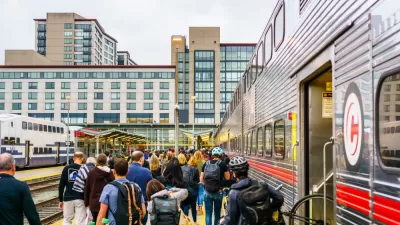An online calculator helps companies determine the broader impacts of their decisions to continue working remotely or return to the office.

Although remote work seems climate-friendly, "the reality is more complicated," writes Sarah Holder in Bloomberg CityLab. A new tool from Watershed Technology Inc. can help companies calculate the environmental impact of returning to the office or letting their employees continue working from home.
Watershed's website explains that, while remote work reduces the energy used in offices, it "shifts carbon: Emissions from energy and food still exist, but at employees’ homes, where they may be better or worse than in the office." Additionally, "a decentralized workforce might lead to more quarterly trips to meet face-to-face," and an exodus to the suburbs could mean increased carbon footprints for more households. The calculator lets companies "assess their greenhouse emissions more holistically, from the power their offices consume to the fuels burned in their supply chain" in order to "measure their impact, make plans to reduce it and make reports on progress."
When it comes to whether remote work is greener than returning to the office, "geography matters," says Holder. "The data analytics company ENGIE Impact suggested that if car commuting is already the status quo for employees at a given office, 'a reduction in commuting is the most reliable way to reduce carbon — even after factoring in the potential for increased energy use in a WFH environment.'" For companies whose employees already relied heavily on public transit, the reduction in carbon will be less impactful. According to Watershed, "the differences between cities are a result of different average household emissions per city, different electricity emissions based on which grid the city is a part of, and the mix of power generation for the grid, as well as average commute distances and respective transport mix for each city."
FULL STORY: The Environmental Implications of the Return to the Office

Maui's Vacation Rental Debate Turns Ugly
Verbal attacks, misinformation campaigns and fistfights plague a high-stakes debate to convert thousands of vacation rentals into long-term housing.

Planetizen Federal Action Tracker
A weekly monitor of how Trump’s orders and actions are impacting planners and planning in America.

In Urban Planning, AI Prompting Could be the New Design Thinking
Creativity has long been key to great urban design. What if we see AI as our new creative partner?

King County Supportive Housing Program Offers Hope for Unhoused Residents
The county is taking a ‘Housing First’ approach that prioritizes getting people into housing, then offering wraparound supportive services.

Researchers Use AI to Get Clearer Picture of US Housing
Analysts are using artificial intelligence to supercharge their research by allowing them to comb through data faster. Though these AI tools can be error prone, they save time and housing researchers are optimistic about the future.

Making Shared Micromobility More Inclusive
Cities and shared mobility system operators can do more to include people with disabilities in planning and operations, per a new report.
Urban Design for Planners 1: Software Tools
This six-course series explores essential urban design concepts using open source software and equips planners with the tools they need to participate fully in the urban design process.
Planning for Universal Design
Learn the tools for implementing Universal Design in planning regulations.
planning NEXT
Appalachian Highlands Housing Partners
Mpact (founded as Rail~Volution)
City of Camden Redevelopment Agency
City of Astoria
City of Portland
City of Laramie





























